Category
Recent Comments
Trending
-
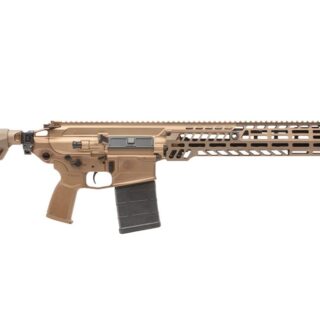 SIG Sauer MCX Virtus
Rated 0 out of 5
SIG Sauer MCX Virtus
Rated 0 out of 5$4,450.00Original price was: $4,450.00.$4,099.00Current price is: $4,099.00. -
 Heckler & Koch MR762A1
Rated 0 out of 5
Heckler & Koch MR762A1
Rated 0 out of 5$4,010.00Original price was: $4,010.00.$3,790.01Current price is: $3,790.01. -
 FN SCAR 17S
Rated 0 out of 5
FN SCAR 17S
Rated 0 out of 5$3,900.00Original price was: $3,900.00.$3,620.00Current price is: $3,620.00. -
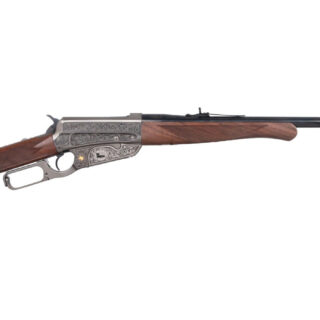 Winchester 1895 Texas Rangers 200th Anniversary Custom Grade 30-06 Springfield Rifle with Engraved Receiver and Walnut Stock
Rated 0 out of 5
Winchester 1895 Texas Rangers 200th Anniversary Custom Grade 30-06 Springfield Rifle with Engraved Receiver and Walnut Stock
Rated 0 out of 5$3,450.00Original price was: $3,450.00.$3,099.01Current price is: $3,099.01. -
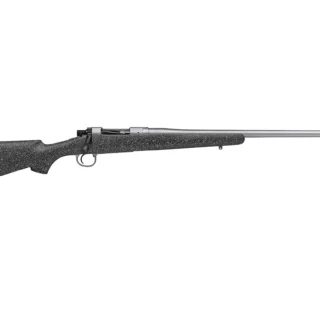 Nosler M21 Bolt Action Centerfire Rifle
Rated 0 out of 5
Nosler M21 Bolt Action Centerfire Rifle
Rated 0 out of 5$2,950.00Original price was: $2,950.00.$2,499.00Current price is: $2,499.00. -
 Desert Eagle Gold .50 A.E. MARK XIX TITANIUM GOLD
Rated 5.00 out of 5
Desert Eagle Gold .50 A.E. MARK XIX TITANIUM GOLD
Rated 5.00 out of 5$3,010.00Original price was: $3,010.00.$2,399.00Current price is: $2,399.00. -
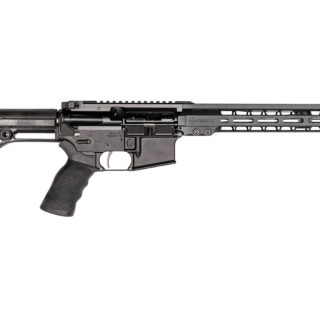 M-15 13 COMPETITION RIFLE
Rated 0 out of 5
M-15 13 COMPETITION RIFLE
Rated 0 out of 5$2,225.00Original price was: $2,225.00.$2,039.00Current price is: $2,039.00. -
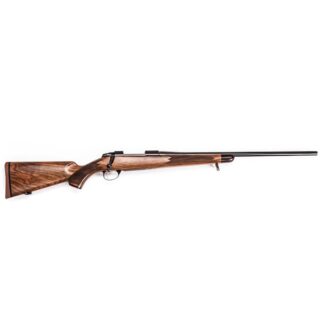 Nosler M48 Heritage Bolt Action Centerfire Rifle
Rated 0 out of 5
Nosler M48 Heritage Bolt Action Centerfire Rifle
Rated 0 out of 5$2,225.00Original price was: $2,225.00.$1,895.00Current price is: $1,895.00. -
 Daniel Defense DDM4 V7 Semi-Auto Rifle
Rated 0 out of 5
Daniel Defense DDM4 V7 Semi-Auto Rifle
Rated 0 out of 5$1,980.00Original price was: $1,980.00.$1,820.00Current price is: $1,820.00. -
 Springfield Armory Standard M1A Semi-Auto Rifle
Rated 0 out of 5
Springfield Armory Standard M1A Semi-Auto Rifle
Rated 0 out of 5$1,900.00Original price was: $1,900.00.$1,720.00Current price is: $1,720.00. -
 IWI Tavor X95 Semi-Automatic Centerfire Rifle
Rated 0 out of 5
IWI Tavor X95 Semi-Automatic Centerfire Rifle
Rated 0 out of 5$1,850.00Original price was: $1,850.00.$1,690.00Current price is: $1,690.00. -
 MARLIN 336 TACTICAL 30/30WIN
Rated 0 out of 5$1,509.99
MARLIN 336 TACTICAL 30/30WIN
Rated 0 out of 5$1,509.99
How Much is a Glock 18 automatic 9mm As a true fully automatic pistol the G18 is one of the most specialized GLOCK pistols. With an external fire selector at the rear of the slide, you can switch from semi-automatic to full-automatic firing mode.
It comes with an extended 19-round magazine and can provide greater firepower with the optional 33-round magazine. The rate of fire in full-automatic mode is approximately 20 rounds per second.
Released in 1987 the pistol has the same characteristics as other previous models and the frame size of the service pistol classic G17.
The G18 is matte black in color. It has maintenance stripes placed at the front and at the back of the stock, a rectangular trigger guard ending in a point on its lower part, and, at the front, the rear sight and fixed sight.
How Much is a Glock 18
The U.S. experimented with a fully automatic 1911 with 30-round magazines — hilarious for a platform that routinely struggles to get through 7-round mags without jamming.
Germany’s Mauser C96 saw a few select-fire iterations that mostly cooked off rounds from overheating after sustained fire.
Glock18 automatic 9mm FOR SALE

Mauser C96 (Photo: Forgotten Weapons)
And the Soviets adopted a machine pistol in the APS Stechkin, although the AKS74U eventually replaced it.
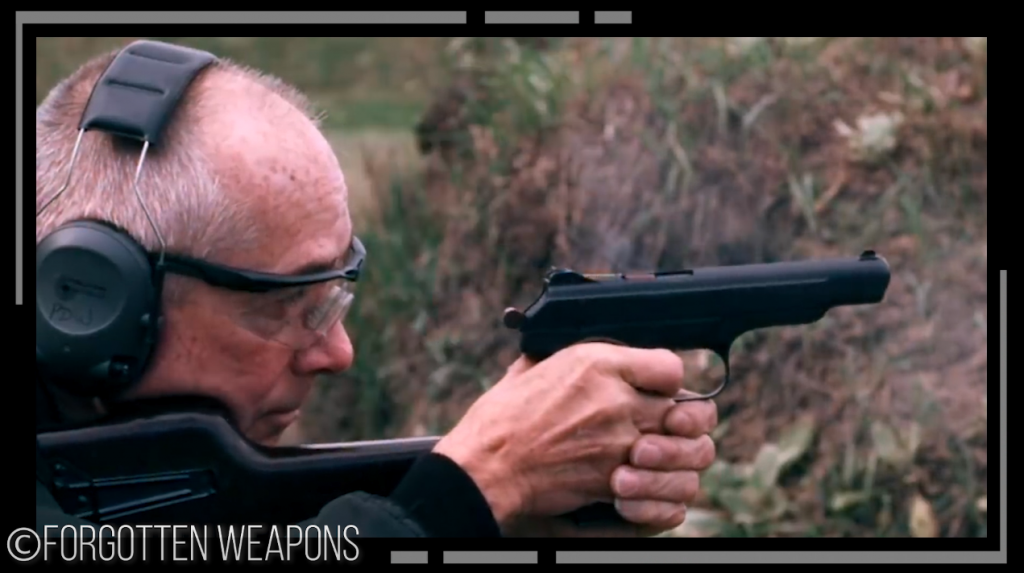
How Much is a Glock 18
Realistically, most firearms designers experimenting with machine pistols kind of came to the same conclusion…
Outside of relatively specific circumstances, there are just not many scenarios in which a fully automatic handgun will outperform a submachine gun.
Perhaps, above all else, fully automatic capabilities jammed into a package that small tends to be pretty tough to control.

So where exactly does the Glock18 automatic 9mm fit into this?
Glad you asked…we’re going to dive into the history behind the iconic full-Glock18 automatic 9mm. We’ll walk through how it came to be, and, even better, we got our hands on one, so we can take it to the range.
Glock18 automatic 9mm For Sale Online
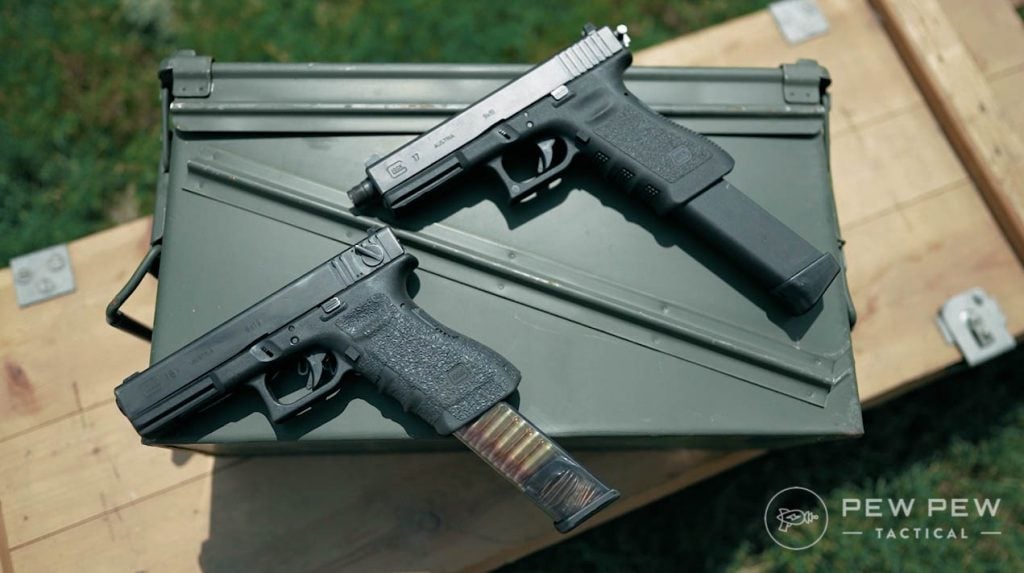
We find the marking of the model on the left front of the barrel. This is compensated. It is thus longer on the Glock18 automatic 9mm because extended from the compensator, than on the Glock18 automatic 9mm. The fire selector is on the left side of the carcass.
How Much is a Glock 18
– Operation: single action and free burst
– Ammunition: caliber 9 × 19 mm Parabellum
– Total length:
– Glock 18: 22.4cm
– Glock 18C: 18.6cm
– Barrel length:
– Glock 18: 13.4 cm (compensator not included)
– Glock 18C: 11.4cm
– Magazine capacity: 17/19/31/33 rounds
– Mass of the weapon with an empty magazine:
– Glock 18: 700g
– Glock 18C: 670g
– Mass of the weapon with a full magazine:
– Glock18 automatic 9mm: 900 (17 rounds) at 1,180 g (33 rounds)
– Glock 18 C: 875 g (17 rounds) to 1,150 g (33 rounds)
– The theoretical rate of fire: 1100-1300 rounds per minute
– Initial projectile velocity: 330-400 meters per second
Glock18 automatic 9mm
As a true fully automatic pistol the G18 is one of the most specialized GLOCK pistols. With an external fire selector at the rear of the slide you can switch from semi-automatic to full-automatic firing mode.
It comes with an extended 19 round magazine and can provide greater firepower with the optional 33-round magazine. The rate of fire in full-automatic-mode is approximately 20 rounds per second.
Released in 1987 the pistol has the same characteristics like other previous models and the frame size of the service pistol classic G17.
How Much is a Glock 18 is a selective-fire variant of the Glock 17 pistol. It is chambered in 9mm and features a fully-automatic firing mode, in addition to the semi-automatic mode found on most handguns. The Glock 18 has a high-capacity magazine and a rate of fire of around 1,200 rounds per minute. It is primarily used by military and law enforcement units that require a high volume of fire in close-quarter combat situations.
How Much is a Glock 18 FOR Sale at Midwayweaponsshop.com
The Glock 18 is a fully automatic pistol chambered in 9mm. It is a select-fire weapon that can shoot in both semi-automatic and fully automatic modes. It is primarily used by military and law enforcement personnel. Is there anything specific you would like to know about the Glock 18?
The standard magazine capacity of the Glock 18 is 17 rounds. However, it can also accept larger capacity magazines such as the 33-round Glock 18 magazine.
How Much is a Glock 18 is a fully automatic pistol chambered in 9mm. It is known for its high rate of fire and is commonly used by military and law enforcement agencies. The standard magazine capacity of the Glock 18 is 17 rounds, but it can also accept larger capacity magazines such as the 33-round Glock 18 magazine. These larger magazines provide a higher ammunition capacity, which can be beneficial in certain situations where a higher volume of fire is required.
automatic 9mm TAGs
, 7.62×39 wolf , 380 ammo bulk 1000, .45 bulk ammo, how much does 1000 rounds of 7.62 weight, .223 ammo bulk, magtech 9mm 1000 rounds – free shipping, bulk ammo 30-30, 556 ammo green tip, bulk ammo.com review, winchester ballistic silvertip 308 150 grain for sale, winchester ballistic silvertip 300 win mag, federal 308 brass, 20 foot short mag, winchester 22-250 ammo 45 grain, incendiary 9mm, winchester 30-06 accubond ct 180 gr, 7mm08 federal fusion in stock, 22-250 winchester 45 grain jhp, 308 bulk ammo, bulk ammo 9mm, 7.62×39 bulk ammo, 9mm 1000 rounds, 45 acp bulk ammo, 1000 9mm rounds, .308 ammo, 9mm 1000, federal 223 ammo – 1000 rounds, 22 ammo 1000 rounds, 1000 rounds 556, bulk 9mm, .223 bulk ammo, 5.56 bulk ammo 5000 rounds, buy bulk ammo, bulk ammo 7.62×39, 5.56, 45 acp ammo, 7.62 x39, ammo for sale, 10mm ammo, .223 ammo,
How Much is a Glock 18
In the event that you are searching for mass ammo, you went to the right site! We highly esteem offering unquestionably the best arrangements to the most genuine shooters for mass handgun ammunition, mass rifle ammunition, mass shotgun ammunition, and mass rimfire ammunition.
Look at our huge determination of in-stock ammo. We convey every one of the most famous types and a gigantic determination of more specialty types as well. Anything you desire, we have it estimated modest and prepared to transport quick.
Glock (stylized as GLOCK) is a brand of polymer–framed, short recoil-operated, locked-breech semi-automatic pistols designed and produced by Austrian manufacturer Glock Ges.m.b.H.
The firearm entered Austrian military and police service by 1982 after becoming the top performer in reliability and safety tests.[10]
Glock pistols have become the company’s most profitable line of products, and have been supplied to national armed forces, security agencies, and police forces in at least 48 countries.[11] Glocks are also popular firearms among civilians for recreational and competition shooting, home- and self-defense, both in concealed or open carry.[12] In 2020, the Glock 19 was the best selling pistol on GunBroker.com.[13]
History How Much is a Glock 18
The company’s founder and head engineer, Gaston Glock, had no experience with firearms design or manufacture at the time their first pistol, the Glock 17, was being prototyped. Glock had extensive experience in advanced synthetic polymers, which was instrumental in the company’s design of the first commercially successful line of pistols with a polymer frame.[14] Glock introduced ferritic nitrocarburizing into the firearms industry as an anticorrosion surface treatment for metal gun parts.[15]
Development[edit]
In 1980, the Austrian Armed Forces announced that it would seek tenders for a new, modern duty pistol to replace their World War II–era Walther P38 handguns.[10] The Federal Ministry of Defence of Austria formulated a list of 17 criteria for the new generation service pistol, including requirements that it would be self loading; fire the NATO-standard 9×19mm Parabellum round; the magazines were not to require any means of assistance for loading; be secure against accidental discharge from shock, strike, and drop from a height of 2 m (6 ft 7 in) onto a steel plate.[10] After firing 15,000 rounds of standard ammunition, the pistol was to be inspected for wear. The pistol was to then be used to fire an overpressure test cartridge generating 5,000 bar (500 MPa; 73,000 psi).[dubious – discuss] The normal maximum operating pressure (Pmax) for the 9 mm NATO is 2,520 bar (252 MPa; 36,500 psi).[16]
How Much is a Glock 18 became aware of the Austrian Army‘s planned procurement, and in 1982, assembled a team of Europe’s leading handgun experts from military, police, and civilian sport-shooting circles to define the most desirable characteristics in a combat pistol.[10] Within three months, Glock had developed a working prototype that combined proven mechanisms and traits from previous pistol designs.[17] In addition, the plan was to make extensive use of synthetic materials and modern manufacturing technologies, which led to the Glock 17 becoming a cost-effective candidate.
Several samples of the How Much is a Glock 18 (so named because it was the 17th patent procured by the company)[18] were submitted for assessment trials in early 1982, and after passing all of the exhaustive endurance and abuse tests, the Glock emerged as the winner.[19][20][21] According to Friedrich Dechant, former Head of the Austrian Armaments and Defence Technology Agency, the Glock P80 was clearly superior to other handguns in terms of performance, handling, charging capacity and price.[22]
The handgun was adopted into service with the Austrian military and law enforcement in 1982 as the Pistole 80 (P80),[23] with an initial order for 25,000 guns.[17] The Glock 17 outperformed eight different pistols from five other established manufacturers (Heckler & Koch of Germany offered their P7M8, P7M13, and P9S, SIG Sauer of Switzerland bid with their P220 and P226 models, Beretta of Italy submitted their model 92SB-F, FN Herstal of Belgium proposed an updated variant of the Browning Hi-Power, and the Austrian Steyr Mannlicher entered the competition with the GB).[24]
The results of the Austrian trials sparked a wave of interest in Western Europe and overseas, particularly in the United States, where a similar effort to select a service-wide replacement for the M1911 had been going on since the late 1970s (known as the Joint Service Small Arms Program). In late 1983, the United States Department of Defense inquired about the Glock pistol and received four samples of the Glock 17 for unofficial evaluation.[25] How Much is a Glock 18 was then invited to participate in the XM9 Personal Defense Pistol Trials, but declined because the DOD specifications would require extensive retooling of production equipment and providing 35 test samples in an unrealistic time frame.[25]
In 1985, after joint Norwegian and Swedish trials from 1983 to 1985, the Glock 17 was accepted into service as the P80 in Norway, and in 1988 as the Pistol 88 in Sweden, where it surpassed all prior NATO durability standards.[26][27][25] As a result, the Glock 17 became a standard NATO-classified sidearm and was granted a NATO Stock Number (1005-25-133-6775).[25] By 1992, some 350,000 pistols had been sold in more than 45 countries, including 250,000 in the United States alone.[23]
Starting in 2013, the British Armed Forces began replacing the Browning Hi-Power pistol with the Glock 17 Gen 4, due to concerns about weight and the external safety of the Hi-Power.[28] The British preferred the Glock 17 Gen 4 over the Beretta Px4 Storm, FN FNP, Heckler & Koch P30, SIG Sauer P226, Smith & Wesson M&P, and Steyr M9A1 of which 19 pistols each, all chambered in 9×19 mm Parabellum, were entered in the R9GSP trials.[29][30]
The French Armed Forces (FAF) in 2020 began replacing their MAC Mle 1950 and, to a lesser extent, their PAMAS G1 pistols with Glock 17 Gen 5 models specifically made for the FAF.[31] The French preferred the Glock 17 Gen 5 over the HS2000 and CZ P-10 offerings that also made it to the final selection phase.[32]
Product evolution[edit]
How Much is a Glock 18 has updated its basic design several times throughout its production history.
First-generation models[edit]
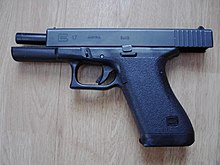
The first-generation (Gen 1) Glock pistols are most notably recognized by their smoother “pebble finish” grip and finger groove-less frames. The Gen 1 frame pattern and design was used by Glock from 1982 through 1988 and pre-dates the checkered grip patterns used in the second generation of Glock pistols. The first Glock 17s imported to the US were serialized with an alpha-numeric (two-letter prefix followed by three numbers) stamped into the slide, barrel, and a small metal plate inserted into the bottom side of the polymer frame. The first documented Glock 17s (by serial number) imported into the US were from the AF000 series in January 1986, followed by AH000, AK000, and AL000.[33] These early Glock (Gen 1) pistols (serial number prefix AF through AM) were also manufactured with a barrel that had a smaller overall diameter and thinner bore walls, later known as “pencil barrels”. These early Glock 17 “pencil barrel” pistols are considered rare and highly desirable by Glock collectors.[original research?] The barrels were later redesigned with thicker bore walls and manufacturing continued to evolve and improve the design of Glock pistols.[34]
Many of the first-generation Glocks were shipped and sold in the iconic “Tupperware” style plastic boxes. The earliest Glock boxes had ammunition storage compartments that allowed for 17 rounds of 9mm to be stored with the pistol. This box design was later changed by Glock to meet BATF import requirements and the ammunition storage compartments were removed.[34]
Second-generation models[edit]
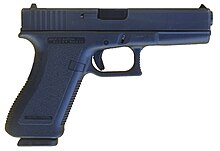
A mid-life upgrade to the Glock pistols involved the addition of checkering on the front strap and trigger guard and checkering and serrations to the back strap. These versions, introduced in 1988, were informally referred to as “second-generation” models. To meet American ATF regulations, a steel plate with a stamped serial number was embedded into the receiver in front of the trigger guard. In 1991, an integrated recoil spring assembly replaced the original two-piece recoil spring and tube design. The magazine was slightly modified, changing the floorplate and fitting the follower spring with a resistance insert at its base.[citation needed]
Third-generation models[edit]
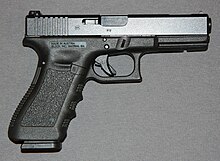
In 1998, the frame was further modified with an accessory rail (called the “Universal Glock rail”) similar to a picatinny rail to allow the mounting of laser sights, tactical lights, and other accessories. Thumb rests on both sides of the frame and finger grooves on the front strap were added. Glock pistols with these upgrades are informally referred to as (early) “third-generation” models. Later third-generation models additionally featured a modified extractor that serves as a loaded chamber indicator, and the locking block was enlarged, along with the addition of an extra cross pin to aid the distribution of bolt thrust forces exerted by the locking block. This cross pin is known as the locking block pin and is located above the trigger pin.[35]
The polymer frames of third-generation models can be black, flat dark earth, or olive drab. Besides that, non-firing dummy pistols (“P” models) and non-firing dummy pistols with resetting triggers (“R” models) have a bright red frame, and Simunition-adapted practice pistols (“T” models) a bright blue frame for easy identification.[36]
In 2009, the Glock 22 RTF2 (Rough Textured Frame 2) (chambered in .40 S&W) was introduced. This pistol featured a new checkering texture around the grip and new scalloped (fish gill-shaped) serrations at the rear of the sides of the slide.[37][38] Many of the existing models became available in the RTF2 version, including the 17,[39] 31, 32, 23, 21, and 19. Some of those did not have the fish gills.[original research?]
Fourth-generation models[edit]
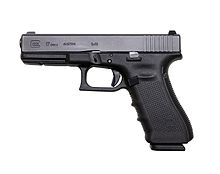

At the 2010 SHOT Show, Glock presented the “fourth generation”, now dubbed “Gen4” by Glock itself.[40] Updates centered on ergonomics and the recoil spring assembly. The initial two fourth-generation models announced were the full-sized Glock 17 and Glock 22, chambered for the 9×19 mm Parabellum and .40 S&W cartridges, respectively. The pistols were displayed with a modified rough-textured frame, grip checkering, and interchangeable backstraps of different sizes. “Gen4” is rollmarked on the slide next to the model number to identify the fourth-generation pistols.
The basic grip size of the fourth-generation Glock pistols is slightly smaller compared to the previous design. A punch is provided to remove the standard trigger housing pin and replace it with the longer cross pin needed to mount the medium or large backstrap that will increase the trigger distance by 2 mm (0.079 in) or 4 mm (0.16 in). With the medium backstrap installed, the grip size is identical to the third-generation pistols. The magazine release catches are enlarged and reversible for left-handed use.[41] To use the exchangeable magazine release feature, fourth-generation Glock magazines have a notch cut on both sides of the magazine body. Earlier versions of the magazines will not lock into the Gen4 pistols if the user has moved the magazine release button to be operated by a left-handed user. Gen4 magazines will work in older models.[42]
Mechanically, fourth-generation Glock pistols are fitted with a dual recoil spring assembly to help reduce perceived recoil and increase service life expectancy. Earlier subcompact Glock models such as the Glock 26 and Glock 30 have already used a dual recoil spring assembly that was carried over to the fourth-generation versions of those models. The slide and barrel shelf have been resized, and the front portion of the polymer frame has been widened and internally enlarged, to accommodate the dual recoil spring assembly. The trigger mechanism housing has also been modified to fit into the smaller-sized grip space.[43][44][45][46][47]
The introduction of fourth-generation Glock pistols continued in July 2010 when the Glock 19 and Glock 23, the reduced size “compact” versions of the Glock 17 and Glock 22, became available for retail.[48] In late 2010, Glock continued the introduction of fourth-generation models with the Glock 26 and Glock 27 “subcompact” variants.
In January 2013, more fourth-generation Glock pistols were introduced commercially during the annual SHOT Show, including the Glock 20 Generation 4 along with other fourth-generation Glock models.
2011 recoil spring assembly exchange program[edit]
In September 2011, Glock announced a recoil spring exchange program in which the manufacturer voluntarily offers to exchange the recoil spring assemblies of its fourth-generation pistols (with the exception of the “subcompact” Glock 26 and Glock 27 models) sold before 22 July 2011 at no cost “to ensure our products perform up to GLOCK’s stringent standards”, according to the company.[49]
M series[edit]
On 29 June 2016, the United States Federal Bureau of Investigation (FBI) awarded a contract to Glock to provide new 9×19mm Parabellum chambered duty pistols.[50] The solicitation specifications deviated from the specifications of Glock fourth-generation models.[51]
In August 2016, the Indianapolis Metro Police Department (IMPD) started training with a batch of Glock 17M pistols. The most obvious difference with the Glock third- and fourth-generation models on published images is the omission of finger grooves on the grip.[52] In October of that year, the IMPD issued a 17M voluntary recall following failures encountered while dry firing the pistols during training. According to Major Riddle with the IMPD, “Glock is working to correct the problem and we hope to begin issuing the new [17Ms] as soon as December.”[53][54]
Fifth-generation models[edit]
In August 2017, Glock presented the “fifth generation” or “Gen 5”. The revisions centered on ergonomics and improving reliability. Many parts of fifth-generation Glock pistols cannot be interchanged with those of the previous generations. The two fifth-generation models announced were the Glock 17 and Glock 19, chambered for the 9×19mm Parabellum. Some conspicuous changes on the fifth-generation models are ambidextrous slide stop levers, DLC surface finish for barrel and slide, a barrel featuring a revised style of polygonal rifling (called the “Glock Marksman Barrel” by Glock), a deeper recessed barrel crown, omission of the finger grooves on the grip, a flared magazine well, and a reintroduction of a half-moon-shaped cutout on the bottom front of the grip. The locking block pin located above the trigger pin that was introduced in the third generation is omitted. Many internal parts were less conspicuously revised.[55][56][57][58][59] “Gen 5” is rollmarked on the slide next to the model number to identify the fifth-generation pistols. The “Gen 5” slide can feature front serrations (FS) to provide an additional tactile traction surface choice. The magazines were also revised for the fifth-generation models: the redesigned magazine floor plates feature a frontward protruding lip to offer grip for manual assisted extraction and the magazine follower[60] became orange colored for easier visual identification.
Design details[edit]
Operating mechanism[edit]
The Glock 17 is a short recoil–operated, locked-breech semi-automatic pistol that uses a modified Browning cam-lock system adapted from the Hi-Power pistol.[61] The firearm’s locking mechanism uses a linkless, vertically tilting barrel with a rectangular breech that locks into the ejection port cut-out in the slide. During the recoil stroke, the barrel moves rearward initially locked together with the slide about 3 mm (0.12 in) until the bullet leaves the barrel and chamber pressure drops to a safe level. A ramped lug extension at the base of the barrel then interacts with a tapered locking block integrated into the frame, forcing the barrel down and unlocking it from the slide. This camming action terminates the barrel’s movement while the slide continues back under recoil, extracting and ejecting the spent cartridge casing. The slide’s uninterrupted rearward movement and counter-recoil cycle are characteristic of the Browning system.[62]
Glock pistols incorporate a number of features intended to enhance reliability in adverse conditions, such as utilizing advanced metal coatings, “stub” slide guides instead of true frame rails, and an unusual cocking mechanism wherein the trigger is partially responsible for cocking the striker.[63] By relying partially on force from the shooter’s trigger finger to cock the striker, a Glock effectively reduces the load on the recoil spring as the slide moves forward into battery, whereas almost all other striker-fired pistols on the market rely fully on the recoil spring to cock the striker.[citation needed] This design gives the recoil spring fewer tasks as the action cycles, helping to ensure that sufficient energy is available to strip a new round from the magazine and achieve full battery even when the breech, chamber, and/or magazine are heavily fouled. For these and other reasons, Glock pistols are commonly considered to be some of the most reliable striker-fired, semi-automatic handguns available, with some independent testing even showing a Glock taking a lead over a SIG Sauer P320[64] in a wet/dry reliability test, even though the latter was selected as the winner of the U.S. Army’s MHS competition.
Features[edit]

The slide features a spring-loaded claw extractor, and the stamped sheet metal ejector is pinned to the trigger mechanism housing.[65] Pistols after 2002 have a reshaped extractor that serves as a loaded chamber indicator. When a cartridge is present in the chamber, a tactile metal edge protrudes slightly out immediately behind the ejection port on the right side of the slide.[66] The striker firing mechanism has a spring-loaded firing pin that is cocked in two stages that the firing pin spring powers. The factory-standard firing pin spring is rated at 24 N (5.4 lbf), but by using a modified firing pin spring, it can be increased to 28 N (6.3 lbf) or to 31 N (7.0 lbf).[67] When the pistol is charged, the firing pin is in the half-cock position. As the trigger is pulled, the firing pin is then fully cocked. At the end of its travel, the trigger bar is tilted downward by the connector, releasing the firing pin to fire the cartridge. The connector resets the trigger bar so that the firing pin will be captured in half-cock at the end of the firing cycle. This is known as a preset trigger mechanism, referred to as the “Safe action” trigger by the manufacturer. The connector ensures the pistol can only fire semiautomatically.
The factory-standard, two-stage trigger has a trigger travel of 12.
Leave a Reply